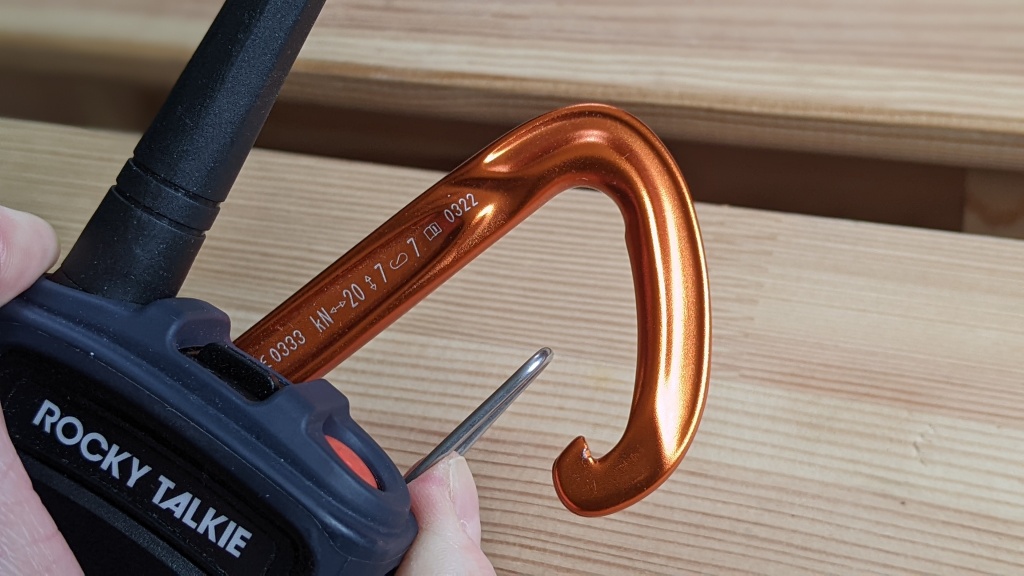Our Verdict
Compare to Similar Products
 This Product
Rocky Talkie Mountain Radio | |||||
|---|---|---|---|---|---|
| Awards | Best Overall | Best Lightweight Radio | Best for Water Use | Best for Licensed Ham Radio Operators | Best Bang for the Buck |
| Price | $110 List $110.00 at Rocky Talkie | $80.43 at Amazon Compare at 3 sellers | $135 List $125.95 at Amazon | $65 List $62.89 at Amazon | $30.00 at REI Compare at 3 sellers |
Overall Score  |
|||||
| Star Rating | |||||
| Bottom Line | Small, sturdy, and dependable, these walkies excel at their essential tasks | An FRS radio that is equally packable and capable | This radio is made to live around the water, but is a poor value if that is not important to you | Licensed ham radio operators will appreciate the amazing range and tons of features | While it has poor range, this inexpensive radio is our top recommendation in its price range |
| Rating Categories | Rocky Talkie Mounta... | Backcountry Access... | Motorola T600 | BaoFeng BF-F8HP | Midland X-Talker T10 |
| Range and Clarity (30%) | |||||
| Ease of Use (25%) | |||||
| Weather Resistance and Durability (15%) | |||||
| Battery Life (15%) | |||||
| Weight and Size (15%) | |||||
| Specs | Rocky Talkie Mounta... | Backcountry Access... | Motorola T600 | BaoFeng BF-F8HP | Midland X-Talker T10 |
| Measured Weight (Single Radio, with Batteries) | 6.7 oz | 6.0 oz | 8.4 oz | 7.8 oz | 3.9 oz |
| Watts | 2W | 2W | .5W, 2W | 1W, 4W, 8W | Not listed |
| Dimensions Body Only | 6.5" x 2.5" x 1.6" | 6.25" x 2.5" x 1.25" | 2.4" x 1.5" x 4.9" | 2" x 1.2" x 3.7" | 2" x 1" x 3.5" |
| Battery Capacity | 1550 mAh | 1800 mAh | 800 mAh | 2,000 mAh | 1,000 mAh |
| Battery Type | Lithium Ion | Lithium Ion | NiMH, Alkaline AA | Lithium Ion | AAA |
| Rechargeable | Yes | Yes | Yes, also can use normal AA batteries | Yes | No |
| Charge Via USB | Yes | Yes | Not with supplied cable, yes with a different micro USB cable | No | n/a |
| Frequency Range | 462 to 467 MHz | 462.55 to 467.71 MHz | 462.55 to 467.71 MHz | 65-108MHz (FM Receive only) 136-174MHz and 400-520MHz (TX/RX) | 462.55 to 467.71 MHz |
| Channels | 128 | 22 | 22 | 100+ | 22 |
| Privacy Codes | 121 available | Yes, 121 available | Yes, 121 available | Yes | Yes, 38 available |
| Keypad Lock | Yes | Yes | Yes | Yes | Yes |
| NOAA Weather Alerts | No | No | Yes | No | Yes |
| VOX | No | No | Yes | Yes | Yes |
| Scan Function | Yes | No | Yes | Yes | Yes |
| Clips to Pack | Yes | Yes | Yes | No (mounts sold separately) | Yes |
Our Analysis and Test Results
Performance Comparison
Range and Clarity
Given how important a radio's range and clarity is, we gave this metric 30% of the total score. We tested the Mountain Radio's range and clarity in real world settings, examining its capabilities when transmission scenarios weren't exactly perfect. We scored each radio based off their performance with minor obstructions, such as trees, to major obstructions, like a ridge or hill between the two radios. We also spent weeks field testing this radio across North America, noting range and clarity findings along the way. The Mountain Radio came in near the top of the pack.
The Mountain Radio had a range of 4.7 miles in minor obstructions and 1.0 miles with major obstructions, making for an excellent FRS option in mountainous/varied terrain. When we had a clear line of sight, we found these radios to offer an impressive range of over 10 miles with clear, intelligible clarity, and didn't find the end of their line of sight range. Whether on a remote glaciated expedition in Alaska or in the deserts of southeastern Utah, this pack-friendly radio continually impressed our testing team, offering more than adequate range for hiking, skiing, or climbing. Best of all, the clarity throughout testing was excellent, only experiencing scratchier transmissions in heavily obstructed scenarios towards the end of the radio's range.
Ease of Use
These radios offer very little in the way of bells and whistles, making them relatively easy to use. Frankly, that works for us. While it's nice to have options like setting your walkie talkies to transmit automatically anytime you talk, we don't find ourselves taking advantage of the extra features in the field. Often we ended up confusing our climbing partners every time we muttered out a plan to get to the next hold.
The Rocky Mountain user manual is straightforward and available online since most will inevitably lose theirs. There is a power button, which also lets you check the battery level and which privacy code you are using (more on that in a second). There is a toggle to let you switch between channels, scan them, or lock your settings in place. The lock is a critical feature for anyone planning rough-and-tumble adventures where buttons could be pressed accidentally.
The volume up button also serves to switch between high and low power settings — simply depress it for two seconds. Depressing the volume down button for two seconds allows you to choose a privacy code, which we'll explain below.
There are 22 channels or radio frequencies available for FRS radios to use. If you've ever tried to use them in a crowded outdoor setting like a festival, you know those are quickly claimed. Thus, privacy codes; most walkie talkies today come with a range of them. They're also known as subchannels and let you use the same channel as someone else without interfering with their conversation and vice versa. The Rocky Talkies come with 106 present channel/privacy code combinations, giving you 128 channels to choose from before you even have to futz with the 121 separate privacy codes.
While the streamlined interface is relatively easy to navigate, the Rocky Talkies' simplicity does have some downsides. They don't allow you to access the National Oceanic and Atmospheric Administration's (NOAA) weather channels. When you're in the backcountry for any length of time, having that information can make a big difference in your safety and comfort level.
The microphone on these radios also isn't that loud, so you need to be sure to clip these closer to your ears. There is an optional waterproof hand microphone and speaker that attaches through a mic/sp port available as an additional purchase. We didn't test it, but we think it would probably help.
Weather Resistance and Durability
The Rocky Talkies are rated as IP56 or as splash and snowproof but not submergible. We used them in snow storms and sprayed them with a shower head for five seconds, and they continued working perfectly. The units are simple, with little moving or isolated parts to break, and we expect them to last.
The only possible entry points for water are the charging and microphone/speaker ports, which both have substantial and fairly secure rubber flaps. These covers limit the amount of moisture that can enter the units. These radios also sport shatterproof LED screens. There's no glass to break. And we agree with Rocky Talkie that using a carabiner to secure the radio to a pack works more consistently than the light-duty plastic clips of many of its competitors. The company also offers a leash to keep it more secure if you need to remove it from your pack to use it, which we often did.
Battery Life
Battery life makes up 15% of the total score of each walkie. We tested this metric by sizing up the total transmit time and total time needed to recharge the battery from dead back to 100%. We also used each radio on back-to-back days with similar amounts of communication to compare and contrast our findings. This radio came in near the top of the pack.
The Mountain Radio impressed us with its battery life, and we confirmed the manufacturer's battery claims of four days on a single charge, even using a high powered channel. While actual time needed before recharging will vary wildly depending on temperature and amount of communication, we found these radios to consistently last even longer than four days, especially when turning these radios off at night. While some will prefer a radio that uses replaceable batteries, we appreciated its rechargeable lithium ion battery, which uses a USB-C cord. If you need the maximum amount of battery life possible, simply use the lower powered channels on the Mountain Radio, which increased the battery life as much as 20% in our testing.
Weight and Size
Weighing 6.7 ounces and measuring 6.5 x 2.5 x 1.6 inches, these radios easily fit in the palm of your hand. These measurements showed that the Rocky Talkies are smaller and lighter than most of the other models in our review.
The Rocky Talkies are compact and light enough that we never feel tempted to leave them behind. The tightly connected carabiner adds to their size but is a secure connection point and provides the antenna with some protection. All told, its lightweight and compact build makes it easier to use.
Should You Buy the Rocky Talkie?
Due to its solid range, excellent clarity, top-notch battery life, compact size, rough-and-tumble build, and simple setup – this is the best walkie-talkie for most people. The only reasons we wouldn't recommend these radios are if you need a waterproof option for extremely wet climates or on-water operation, if you need access to NOAA weather channels, or if you consistently need a longer range than an FRS radio can provide. In the last case, you'd need to upgrade to a GMRS model and earn the FCC license it requires. These aren't the most cost-effective radios out there, but we believe these offer extremely high value for what you pay for.
What Other Walkie Talkies Should You Consider?
If you need to save a little space, we recommend checking out the Midland X-Talker T10, which was one of our favorite budget models. While it doesn't offer nearly the range and clarity of the Rocky Talkie, it works well when you're closer to the other members of your group. It also accesses NOAA weather channels, and with the stark price difference, you'll likely be able to afford more of them. If you do need a waterproof option, check out the Motorola T600. If you need a more powerful radio, check out its bigger sibling, the Rocky Talkie 5 Watt.

















